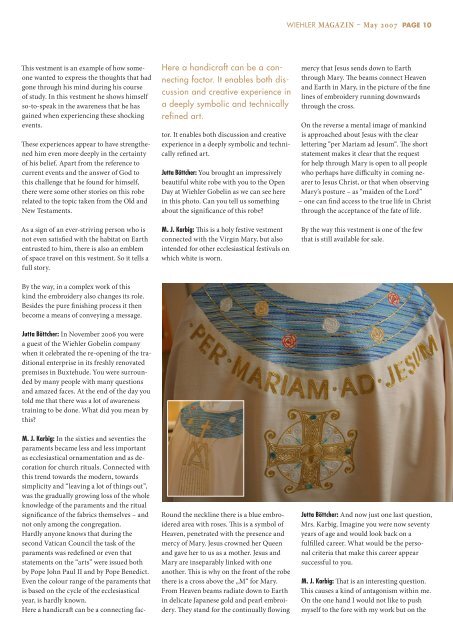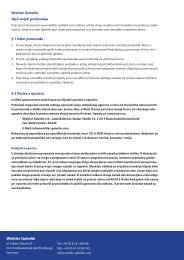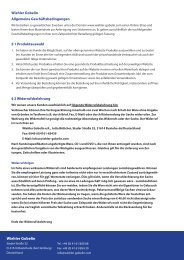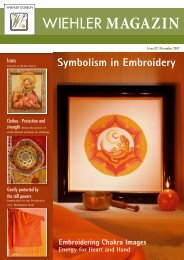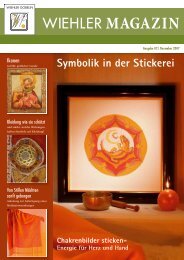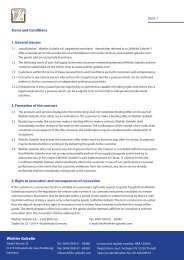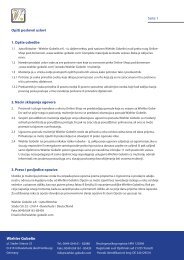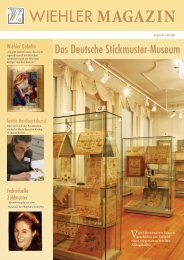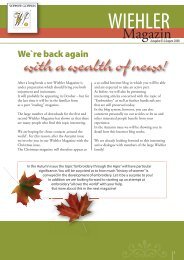Wiehler MAGAZIN - Wiehler Gobelin
Wiehler MAGAZIN - Wiehler Gobelin
Wiehler MAGAZIN - Wiehler Gobelin
Create successful ePaper yourself
Turn your PDF publications into a flip-book with our unique Google optimized e-Paper software.
This vestment is an example of how someone<br />
wanted to express the thoughts that had<br />
gone through his mind during his course<br />
of study. In this vestment he shows himself<br />
so-to-speak in the awareness that he has<br />
gained when experiencing these shocking<br />
events.<br />
These experiences appear to have strengthened<br />
him even more deeply in the certainty<br />
of his belief. Apart from the reference to<br />
current events and the answer of God to<br />
this challenge that he found for himself,<br />
there were some other stories on this robe<br />
related to the topic taken from the Old and<br />
New Testaments.<br />
As a sign of an ever-striving person who is<br />
not even satisfied with the habitat on Earth<br />
entrusted to him, there is also an emblem<br />
of space travel on this vestment. So it tells a<br />
full story.<br />
By the way, in a complex work of this<br />
kind the embroidery also changes its role.<br />
Besides the pure finishing process it then<br />
become a means of conveying a message.<br />
Jutta Böttcher: In November 2006 you were<br />
a guest of the <strong>Wiehler</strong> <strong>Gobelin</strong> company<br />
when it celebrated the re-opening of the traditional<br />
enterprise in its freshly renovated<br />
premises in Buxtehude. You were surrounded<br />
by many people with many questions<br />
and amazed faces. At the end of the day you<br />
told me that there was a lot of awareness<br />
training to be done. What did you mean by<br />
this?<br />
M. J. Karbig: In the sixties and seventies the<br />
paraments became less and less important<br />
as ecclesiastical ornamentation and as decoration<br />
for church rituals. Connected with<br />
this trend towards the modern, towards<br />
simplicity and “leaving a lot of things out”,<br />
was the gradually growing loss of the whole<br />
knowledge of the paraments and the ritual<br />
significance of the fabrics themselves – and<br />
not only among the congregation.<br />
Hardly anyone knows that during the<br />
second Vatican Council the task of the<br />
paraments was redefined or even that<br />
statements on the “arts” were issued both<br />
by Pope John Paul II and by Pope Benedict.<br />
Even the colour range of the paraments that<br />
is based on the cycle of the ecclesiastical<br />
year, is hardly known.<br />
Here a handicraft can be a connecting fac-<br />
here a handicraft can be a con-<br />
necting factor. it enables both dis-<br />
cussion and creative experience in<br />
a deeply symbolic and technically<br />
refined art.<br />
tor. It enables both discussion and creative<br />
experience in a deeply symbolic and technically<br />
refined art.<br />
Jutta Böttcher: You brought an impressively<br />
beautiful white robe with you to the Open<br />
Day at <strong>Wiehler</strong> <strong>Gobelin</strong> as we can see here<br />
in this photo. Can you tell us something<br />
about the significance of this robe?<br />
M. J. Karbig: This is a holy festive vestment<br />
connected with the Virgin Mary, but also<br />
intended for other ecclesiastical festivals on<br />
which white is worn.<br />
Round the neckline there is a blue embroidered<br />
area with roses. This is a symbol of<br />
Heaven, penetrated with the presence and<br />
mercy of Mary. Jesus crowned her Queen<br />
and gave her to us as a mother. Jesus and<br />
Mary are inseparably linked with one<br />
another. This is why on the front of the robe<br />
there is a cross above the „M“ for Mary.<br />
From Heaven beams radiate down to Earth<br />
in delicate Japanese gold and pearl embroidery.<br />
They stand for the continually flowing<br />
<strong>Wiehler</strong> <strong>MAGAZIN</strong> – May 2007 Page 10<br />
mercy that Jesus sends down to Earth<br />
through Mary. The beams connect Heaven<br />
and Earth in Mary, in the picture of the fine<br />
lines of embroidery running downwards<br />
through the cross.<br />
On the reverse a mental image of mankind<br />
is approached about Jesus with the clear<br />
lettering “per Mariam ad Jesum“. The short<br />
statement makes it clear that the request<br />
for help through Mary is open to all people<br />
who perhaps have difficulty in coming nearer<br />
to Jesus Christ, or that when observing<br />
Mary’s posture – as “maiden of the Lord”<br />
– one can find access to the true life in Christ<br />
through the acceptance of the fate of life.<br />
By the way this vestment is one of the few<br />
that is still available for sale.<br />
Jutta Böttcher: And now just one last question,<br />
Mrs. Karbig. Imagine you were now seventy<br />
years of age and would look back on a<br />
fulfilled career. What would be the personal<br />
criteria that make this career appear<br />
successful to you.<br />
M. J. Karbig: That is an interesting question.<br />
This causes a kind of antagonism within me.<br />
On the one hand I would not like to push<br />
myself to the fore with my work but on the


